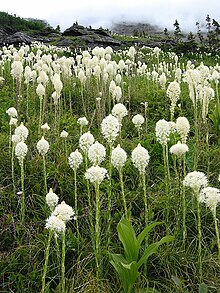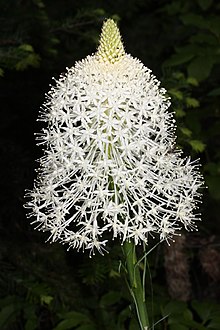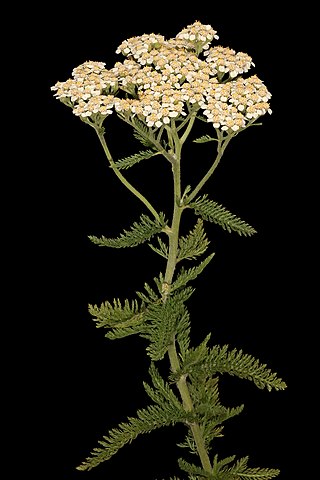
Achillea millefolium, commonly known as yarrow or common yarrow, is a flowering plant in the family Asteraceae. Other common names include old man's pepper, devil's nettle, sanguinary, milfoil, soldier's woundwort, and thousand seal.

Dasylirion wheeleri is a species of flowering plant in the asparagus family (Asparagaceae), native to arid environments of northern Mexico and the southwestern United States.

Maianthemum racemosum, the treacleberry, feathery false lily of the valley, false Solomon's seal, Solomon's plume or false spikenard, is a species of flowering plant native to North America. It is a common, widespread plant with numerous common names and synonyms, known from every US state except Hawaii, and from every Canadian province and territory, as well as from Mexico.

Xerophyllum is a genus of perennial plants from the family Melanthiaceae. The genus is native to North America.

Xerophyllum asphodeloides is a North American species of flowering plants in the Melanthiaceae known by the common names turkey beard, eastern turkeybeard, beartongue, grass-leaved helonias, and mountain asphodel. It is native to the eastern United States, where it occurs in the southern Appalachian Mountains from Virginia to Alabama, and also in the Pine Barrens of New Jersey.

Nolina parryi is a flowering plant that is native to Baja California, southern California and Arizona.

Liatris aspera is a perennial wildflower in the Asteraceae family that is found in central to eastern North America in habitats that range from mesic to dry prairie and dry savanna.

Lomatium utriculatum is a species of flowering plant in the carrot family known by the common name common lomatium or spring gold. It is native to western North America from British Columbia to California, where it grows in many types of habitat including chaparral, and in the Sierra Nevada.

Lysichiton americanus, also called western skunk cabbage (US), yellow skunk cabbage (UK), American skunk-cabbage or swamp lantern, is a plant found in swamps and wet woods, along streams and in other wet areas of the Pacific Northwest, where it is one of the few native species in the arum family.

Iris tenax is a species of Iris, known by the common names tough-leaved iris, Oregon iris, or more colloquially, flag.

Erythronium oregonum is a North American species of flowering plant in the lily family which is known by the common name giant white fawnlily or Oregon fawn-lily.

Goodyera oblongifolia is a species of orchid known by the common names western rattlesnake plantain and giant rattlesnake plantain. It is native to much of North America, particularly in the mountains of the western United States and Canada, from Alaska to northern Mexico, as well as in the Great Lakes region, Maine, Quebec and the Canadian Maritime Provinces.
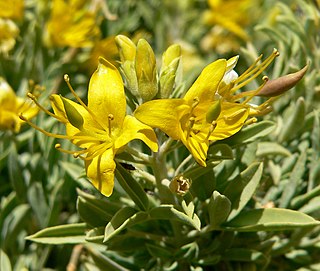
Cleomella arboreasyn. Peritoma arborea, is a perennial shrub or bush in the spiderflower family (Cleomaceae) known by the common names bladderpod, bladderpod spiderflower and burro-fat. It has yellow flowers in bloom all months of the year. It emits a foul odor to discourage herbivory from insects.
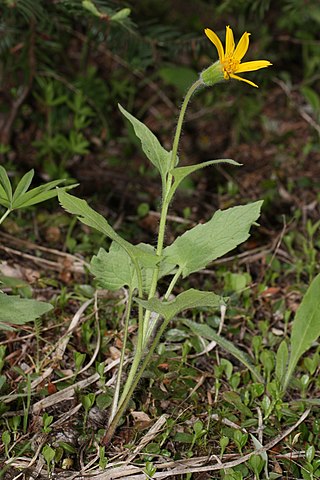
Arnica cordifolia is a species of arnica in the sunflower family, known by the common name heartleaf arnica. It is native to western North America.

Balsamorhiza sagittata is a North American species of flowering plant in the tribe Heliantheae of the family Asteraceae known by the common name Arrowleaf Balsamroot. Also sometimes called Oregon sunflower, it is widespread across western Canada and much of the western United States.
Calycadenia truncata is a species of flowering plant in the family Asteraceae known by the common name Oregon western rosinweed. It is native to western North America.
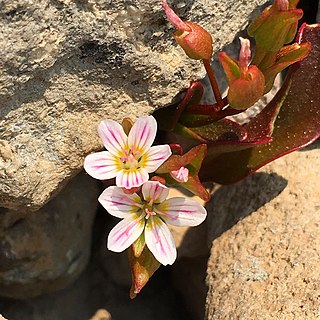
Claytonia nevadensis, known by the common names Sierra springbeauty and Sierra Nevada claytonia, is a species of wildflower in the family Montiaceae. The evolutionary relationship of Claytonia nevadensis to other claytonias is a subject of debate and ongoing genetic studies. Sierra springbeauties are diploid with a chromosome base number of x = 7
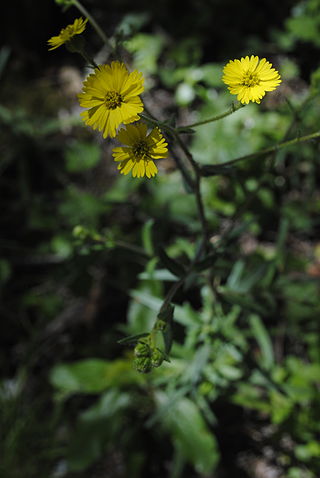
Anisocarpus madioides is a North American species of flowering plant in the family Asteraceae known by the common name woodland madia.

Yucca glauca is a species of perennial evergreen plant, adapted to xeric (dry) growth conditions. It is also known as small soapweed, soapweed yucca, Spanish bayonet, and Great Plains yucca.

Heterotheca villosa, commonly known as the hairy goldenaster, is a species of flowering plant in the family Asteraceae found in central and western North America.
